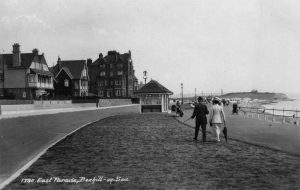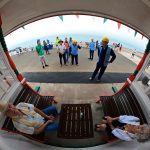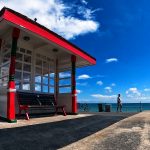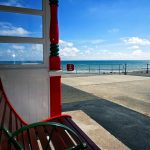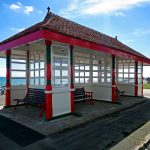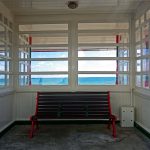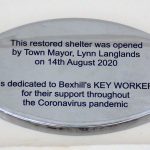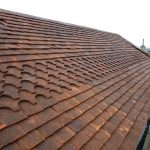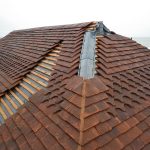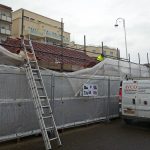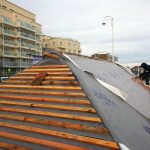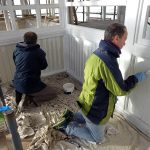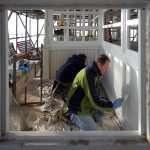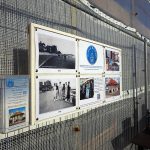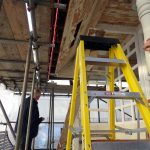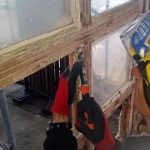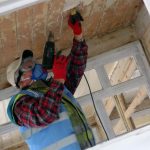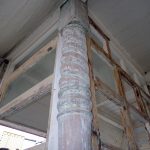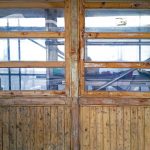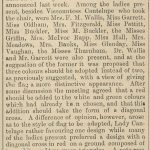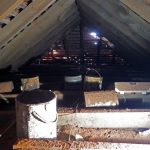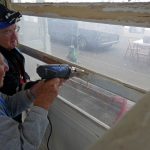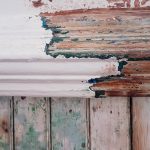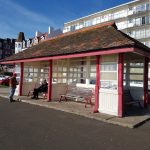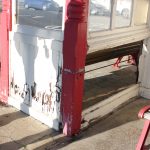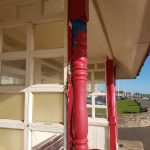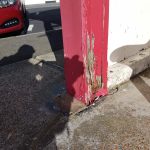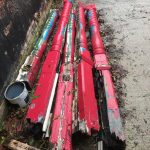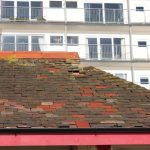- 1925
- 1935
A clip from the film Double Confession (1950) showing the interior of the shelter (no audio):
In early September 2019, Bexhill Heritage received a request from Rother District Council to help out with completing the repairs to the shelter which was only part-way through. We accepted the challenge and completed a complete refurbishment, reopening the shelter in August 2020.
Final Update 10
On the 14th of August 2020 at 9:45am, Mayor Lynn Langlands of Bexhill opened Shelter No.3.
Update 9
Over 2,500 hours of volunteer labour.
Our treasurer, Steve Johnson embarked on painting the shelter just as lockdown came in March. As lockdown came to an end, the painting was almost complete and roof tiling was finished. Finials were made and fitted by Aldershaws. All six benches have been varnished and painted.
Scaffolding has been removed and fencing will come down on next weeks opening.
Update 8
Over 1,600 hours of volunteer labour.
Weather has cleared enough for the contracted roofers to start on the roofing. The shaped tiles, ridge tiles and finials will be hand-made to original specification.
Work is continuing in the shelter, mostly filling of the wood panels. Painting will resume after roofing to avoid dust on the walls.
Update 7
Over 1,200 hours of volunteer labour.
Felting and removing of the old tiles has begun by contractors. Some of the removed ridge tiles have ‘Trade Mark RCR’ imprinted in them, if you know any history of this let us know!
We opened the shelter for festivities on the 22nd December with live music, tombola, mulled wine and an opportunity to go inside the shelter itself and view progress so far.
Update 6
Over 1,000 hours of volunteer labour.
A break in the wet weather meant we could carry on with the priming and get some of the undercoating started.
A new information board has been affixed to the railings outside, showing some history and ongoing work. Do grab one of our new leaflets if you are passing.
Update 5
Over 900 hours of volunteer labour.
Almost all the ceiling paint has been removed and sections of the shelter have now been primed ready for painting.
A mock-up of the chosen colour scheme and re-roofing can be seen below.
Update 4
Over 500 hours of volunteer labour.
The original barley-twist columns are being carefully cleaned to remove any flakes of paint.
The exhausting job of removing the paint from the ceiling is on-going.
Update 3
Whole sections of the shelter are now stripped of paint, showing some beautiful original pine wood.
Most of the discoloured or cracked perspex window panes have been taken out and surrounding putty removed.
RDC Conservation Officer Tanya Szendeffy visited the site to begin deciding a possible colour scheme for the shelter. The red, white and green tricolour will be a common theme throughout, being as they were adopted by the Bexhill Institute as town colours in July 1893 (see below). The other newspaper item shows a colourised version of the flag at the Children’s Jubilee Fete at the Manor House, 1897. Thanks to Bexhill Museum for their help with this research.
Update 2
We opened up the trap door and accessed the loft space. The inspection that was carried out showed a considerable ingress of sand. This is perhaps no surprise as the sea is but metres away and prevailing winds come from the sea. The sand has been blown under the tiles and then settles on and between the rafters. The interior of the roof is in good condition. There is no evidence of rot. We have removed the sand and bagged it up as well as considerable rubbish left by previous contractors. Daylight can be seen inside the roof due to absent or slipped tiles.
Scaffolding has been erected and the projects team are very grateful for the added security and drop sheeting weather protection which has been provided by RDC.
We continue to use heat guns to lift the layers of congealed paint. This has proven to be slow but successful.
Update 1
The week began after a delayed start from bad weather.
We started by scraping down the old paintwork and quickly discovered that the many layers of paint which have built up over the years is unstable and de-laminates quite easily. It was decided that just scraping, rubbing down and painting over the top would not last for very long.
We tested heat guns and this takes all the paint off down to the timber so that we can sand, prime and paint properly. Although this is taking longer to do, one of the benefits is that the quirks and crevices which have been choked with paint are clearing, and the detail such as beading and mouldings are being revealed. We have a steady team working on this task daily.
Initial Condition Survey
Damaged by vandalism
Soffits damaged and missing
Loose roof tiles
Rotted and missing panels
Dry rot in posts
Dry rot in mouldings
Paintwork deteriorated



